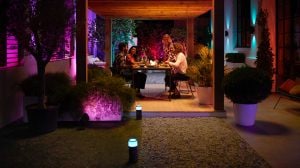January 31, 2025
How to use low-voltage landscape lighting
One of the benefits of smart lighting is how easy it is to use — even outdoors. Thanks to the Low-volt collection of outdoor smart lights, you can easily install path lights to help guide you to the door, deck lighting to create the just the right atmosphere, or even party lights for outdoor occasions.
What is low-voltage landscape lighting?
Low-voltage lights simply plug into any standard wall socket instead of being hardwired directly into your home’s electricity (also called line-voltage lighting or mains). Line voltage in North America is 120 V, and it’s 230 V in most other parts of the world. Low-voltage lighting uses a transformer to reduce that voltage so it’s safer and easier to use.
Philips Hue offers low-voltage landscape lighting with the Low-volt collection, which are specially designed for outdoor spaces.
The transformer in the Philips Hue Low-volt collection is in the included power supply unit (PSU), which comes in two variants in the US: 95 W and 40 W.

How to install low-voltage landscape lighting
When you set up Low-volt outdoor lighting, you’ll only need a few things to get started:
- Hue Bridge (if you already have one for indoor lighting, you can just add outdoor lights to it!)
- Power supply unit (PSU)
- Low-volt light fixture
- Cables
Note: All Low-volt light fixtures come with the necessary cables. All base units include both a PSU and cables. Check the packaging to make sure you have everything you need to get started.
- Place the light fixture where you'd like, ensuring it’s within 50 feet of the closest Philips Hue light in your house or the Hue Bridge.
(Wondering why? Philips Hue smart lights form a mesh network where each light extends the Zigbee signal. If your light is too far from the nearest light or your Hue Bridge, it won’t be able to communicate with your system.) - Connect the extension cable between the light fixture and the PSU. If your light is located close enough to the PSU, this may not be necessary.
- Plug the PSU into an outdoor socket.
- Add the light to your system in the Hue app.

Choosing the right Low-volt power supply unit
When adding new low-voltage lights to your existing setup, keep in mind that one PSU can only power so many lights. To figure out how many lights you can use on a single PSU, simply add up the wattage of the light fixtures:
- Econic pedestal: 8 W
- Calla pedestal: 8 W
- Calla large pedestal: 8 W
- Impress pedestal: 8 W
- Impress wall light: 15.8 W
- Lily spotlight: 8 W
- Lily XL spotlight: 15 W
- Outdoor lightstrip 80 in: 19 W
- Outdoor lightstrip 197 in: 37.5 W
Low-volt setup with 40 W power supply unit
Here’s an example of a Low-volt setup using a 40 W PSU and two types of lights: Lily spotlights and Calla pedestal lights. Both Lily spotlights and Calla pedestals are 8 W each, resulting in this setup:
Lily (8 x 3) + Calla (8 x 2) = 40 W

Low-volt setup with 95 W power supply unit
Here’s an example of a Low-volt setup using a 95 W PSU and three types of lights: Lily spotlights, Calla pedestal lights, and an 80-inch outdoor lightstrip. Both Lily spotlights and Calla pedestals are 8 W each, while the 80-inch outdoor lightstrip is 19 W.
Calla pedestals (8 x 6) + 1 outdoor lightstrip (19 x 1) + Lily spotlight (8 x 3) = 91 W

*Sign up and save 15%. You should receive your code within 1 hour after your subscription, but processing time may vary. This promotion is not valid on email addresses that are already enrolled in the Philips Hue newsletter. Read the Terms & Conditions for this promotion.

